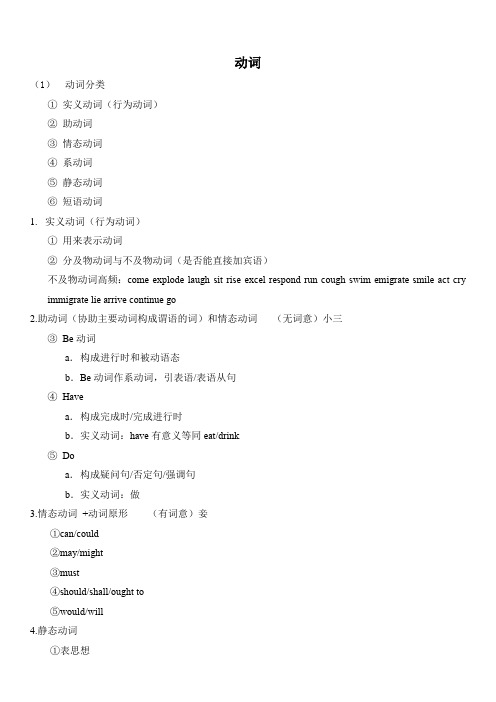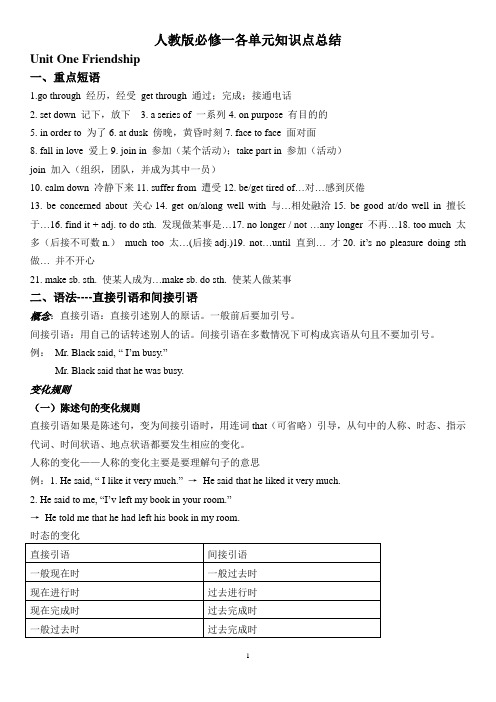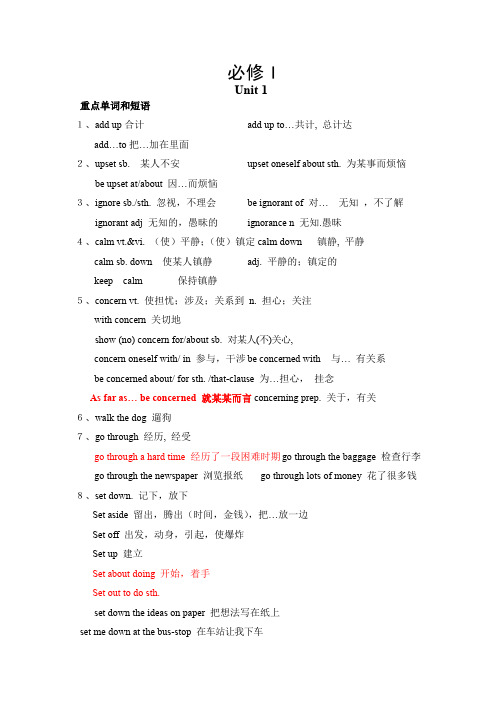高中英语人教版(2019)必修第一册 动词语法知识点复习总结大全
高中英语人教版(2019)必修第一册 动词语法知识点总结大全

动词(1)动词分类①实义动词(行为动词)②助动词③情态动词④系动词⑤静态动词⑥短语动词1.实义动词(行为动词)①用来表示动词②分及物动词与不及物动词(是否能直接加宾语)不及物动词高频:come explode laugh sit rise excel respond run cough swim emigrate smile act cry immigrate lie arrive continue go2.助动词(协助主要动词构成谓语的词)和情态动词(无词意)小三③Be动词a.构成进行时和被动语态b.Be动词作系动词,引表语/表语从句④Havea.构成完成时/完成进行时b.实义动词:have有意义等同eat/drink⑤Doa.构成疑问句/否定句/强调句b.实义动词:做3.情态动词+动词原形(有词意)妾①can/could②may/might③must④should/shall/ought to⑤would/will4.静态动词①表思想Believe,doubt,know,understand②表拥有Have,own,want,contain③表感觉Hear,see,smell④表情感Love,hate,want,need5.动词短语构成:动词+介词或动词+副词(通常与原动词含义不同)(二)动词的形式1.动词原形2.第三人称单数①一般现在时中②主语为第三人称单数,谓语动词要用第三人称单数形式A.直接动词词尾加sB.以字母s,x,ch,sh或o结尾的动词加esC.辅音加y,变y为i加esD.不规则变化3.动名词与现在分词⑥直接词尾加ing⑦词尾去掉e,去掉e加ing⑧ie结尾的,变ie为y加ing⑨辅音+元音+辅音,双写词尾加ing4.动词过去式与过去分词A.规则动词的过去式加edB.以e结尾的动词词尾直接加dC.不规则变化5.动词时态5.1一般现在时形式:①肯定形式:第三人称单数用三单,其他用动词原形②否定形式:主语+do/does not+谓语动词原形③疑问形式:疑问词+do/does+主语+谓语动词原形用法:①现在时段发生的动作:I feel great!②习惯性动作/常发生的动作③表示客观真理④用于电影,赛事,时间的评论,独白,报道等⑤谈论时间表,日程表eg:The train leaves at half past four.⑥一般现在时表将来当主句为将来时或表将来意义时,时间和条件的状语从句必须用一般现在时表将来。
史上最全面的人教版高中英语必修一语法知识点总结.doc

高一主要语法点必修一:直接引语和间接引语(宾语从句);现在进行时表将来;定语从句必修二:定语从句(非限定定从、定从屮的介词前提);被动语态(一般将来时、现在完成时及现在进行时的被动语态)必修三:情态动词;名词性从句(主语从句、宾语从句、表语从句及同位语从句)必修四:主谓一致;非谓语动词(V-ing);构词法必修2第一单元,非限制性定语从句的第二单元一般将来时的主被动第三单元现在完成时的主被动第四单元现在进行时的主被动第五单元介词+which/whom的用法必修3 —二单元情态动词的用法三单元宾语从句和表语从句四单元主语从句五单元同位语从句必修4第一单元主谓一致第二单v-ing作主语和宾语的用法第三单元v-ing作表语,定语和宾语补足语第四单元v・ing作状语第五单元构词法必修5第一单元过去分词作定语和表语第二单元过去分词作宾语补足语第三单元过去分词作状语第四单元倒装句第五单元省略句人教版必修一各单元知识点总结Unit One Friendship一、重点短语1 .go through经历,经受get through通过;完成;接通电话2.set down 记-F,放卜3.a series of 一系列4 on purpose有目的的5.in order to 为了6.at dusk傍晚,黄昏时刻7.face to face 面对面8.fall in love 爱上9.join in参加(某个活动);take part in参加(活动)join加入(组织,团队,并成为其1+1—员)10.calm down冷静下来11.suffer from 遭受12.be/get tired of…对…感到厌倦13.be concerned about 关心14.get on/along well with 与…相处融洽15.be good at/do well in 擅长于...16.find it + adj. to do sth.发现做某事是...17.no longer / not.…any longer 不再•・・18.too much太多(后接不可数it)much too太…(后接adj.)19.not...until 直到… 才20.it's no pleasure doing sth 做… 并不开心21.make sb. sth.使某人成为… make sb. do sth.使某人做某事二、语法•…直接引语和间接引语概念:直接引语:直接引述别人的原话。
Unit 3-4 语法汇总讲义-高中英语新人教版(2019)必修第一册

高中英语必修一语法汇总Unit 3:附加疑问句一、附加疑问句的定义附加疑问句,又称反义疑问句,主要用于口语,其作用是说话人向对方验证自己的陈述或者判断,也可以用于祈使句表示请求或者建议。
二、附加疑问句的构成附加疑问句包括陈述部分和附加疑问部分。
附加疑问部分一般由助动词、be 动词或情态动词和表示主语的代词构成。
组成例句肯定式陈述部分+否定附加疑问部分You often play badminton, don't you?You're going to the gym with me, aren't you?否定式陈述部分+肯定附加疑问部分It's not a real sport, is it?They can't finish it by Friday, can they?含有否定词的陈述部分+肯定附加疑问部分Nobody saw him walk into the room, did they?You've never been to Paris, have you?祈使句+附加疑问部分Come along with me, will you?/can you?/won't you?/can't you?Don't make any noise, will you?附加疑问句的答语与一般疑问句类似,注意其与汉语表达习惯的差异。
如:(1)A:The29th Olympic Games were held in Beijing,weren't they?B:Yes,they were.(Yes, that's right.)(2)A:MichaelJordan started to play basketball in college, didn't he?B:No,he didn't. He first played in a team in senior high school.(3)A:Davidhas been to a boxing match, hasn't he?B:No,he hasn't. He always watches boxing on TV.(4)A:Youcan't cook, can you?你不会做饭,是吗?B:Yes,I can. I'm good at cooking.不,我会。
(完整版)人教版高中英语必修一语法知识点总结

人教版必修一各单元知识点总结Unit One Friendship一、重点短语1.go through 经历,经受get through 通过;完成;接通电话2. set down 记下,放下3. a series of 一系列4. on purpose 有目的的5. in order to 为了6. at dusk 傍晚,黄昏时刻7. face to face 面对面8. fall in love 爱上9. join in 参加(某个活动);take part in 参加(活动)join 加入(组织,团队,并成为其中一员)10. calm down 冷静下来11. suffer from 遭受12. be/get tired of…对…感到厌倦13. be concerned about 关心14. get on/along well with 与…相处融洽15. be good at/do well in 擅长于…16. find it + adj. to do sth. 发现做某事是…17. no longer / not …any longer 不再…18. too much 太多(后接不可数n.)much too 太…(后接adj.)19. not…until 直到…才20. it’s no pleasure doing sth 做…并不开心21. make sb. sth. 使某人成为…make sb. do sth. 使某人做某事二、语法----直接引语和间接引语概念:直接引语:直接引述别人的原话。
一般前后要加引号。
间接引语:用自己的话转述别人的话。
间接引语在多数情况下可构成宾语从句且不要加引号。
例:Mr. Black said, “ I’m busy.”Mr. Black said that he was busy.变化规则(一)陈述句的变化规则直接引语如果是陈述句,变为间接引语时,用连词that(可省略)引导,从句中的人称、时态、指示代词、时间状语、地点状语都要发生相应的变化。
2019人教版)高中英语必修一。知识点归纳 笔记

2019人教版)高中英语必修一。
知识点归纳笔记必修一知识点归纳笔记欢迎单元1.exchange可以用作名词或动词,表示“交换”、“交流”等。
其中,动词exchange可以与for连用,表示“以…为交换条件”、“交换…和…”;也可以与with连用,表示“与某人交换…”;还可以表示“交换意见/想法/观点”等。
2.design作名词时表示“设计”,作动词时表示“为…设计”,常用于被动语态中的“be XXX”,表示“旨在做某事”。
此外,XXX表示“故意地”,反义词为by accident(偶然地)。
表示“忧虑的”、“担心的”、“渴望的”,可以与for连用,表示“为某人/某事忧虑”、“渴望…”等。
XXX则表示“焦虑”,可以与with连用,表示“焦虑地”。
4.XXX表示“恼怒的”、“生气的”,可以与with连用,表示“对某人生气”。
XXX表示“使…生气”,XXX则表示“令人生气的”。
5.r high school表示“高中”,XXX则表示“高级的”、“级别的”,可以与to连用,表示“比某人的职位/地位高”,也可以表示“长辈”、“上司”等。
6.n表示“印象”、“感想”、“影响”,可以用leave/make a XXX…表示“给…留下/产生印象”,也可以用impress vt.表示“给某人留下印象”,impressive则表示“给某人深刻印象的”。
7.XXX表示“集中精力于…”,可以与XXX、XXX、XXX等表达方式替换。
8.leave可以表示“让…一个人待着,不干涉”、“不管,不理会,不碰”,即leave…alone。
也可以表示“搁置一边,不予考虑”、“遗漏,不包括”、“动身去”,即leave aside、leave out、leave for。
12.look forward to doing sthto是介词,后接动词的-ing形式,表示“期待/盼望做某事”。
1.Stick to your goals and keep moving forward。
高一英语人教版必修一全册重点单词短语及句型的归纳

必修IUnit 1重点单词和短语1、add up合计add up to…共计, 总计达add…to把…加在里面2、upset sb. 某人不安upset oneself about sth. 为某事而烦恼be upset at/about 因…而烦恼3、ignore sb./sth. 忽视,不理会be ignorant of 对… 无知,不了解ignorant adj 无知的,愚昧的ignorance n 无知.愚昧4、calm vt.&vi. (使)平静;(使)镇定calm down 镇静, 平静calm sb. down 使某人镇静adj. 平静的;镇定的keep calm 保持镇静5、concern vt. 使担忧;涉及;关系到n. 担心;关注with concern 关切地show (no) concern for/about sb. 对某人(不)关心,concern oneself with/ in 参与,干涉 be concerned with 与… 有关系be concerned about/ for sth. /that-clause 为…担心,挂念As far as… be concerned 就某某而言concerning prep. 关于,有关6、walk the dog 遛狗7、go through 经历, 经受go through a hard time 经历了一段困难时期go through the baggage 检查行李go through the newspaper 浏览报纸go through lots of money 花了很多钱8、set down. 记下,放下Set aside 留出,腾出(时间,金钱),把…放一边Set off 出发,动身,引起,使爆炸Set up 建立Set about doing 开始,着手Set out to do sth.set down the ideas on paper 把想法写在纸上set me down at the bus-stop 在车站让我下车9、a series of 一系列的, 一连串的a series of books 丛书 a series of stamps 一套邮票a series of pictures 连环画10、on purpose 故意地= by design= deliberately by chance/accident= accidentallylie to sb. on purpose 故意向某人撒谎on purpose to do sth. 为了…而特地go there on purpose to see sb. 特意到那里去看某人for/with the purpose of 为了…地目的11、in order to/ so as to (do sth.) 为了, 以……为目的so as to “为了”, 只能用在句中。
高中英语人教版(2019)必修第一册句式翻译汇总复习课件

在分词短语作结果状语;lead)Each statue has a different face, _le_a_d__in_g__r_e_s_e_a_r_c_h_e_r_s_t_o__b_e_lieve
句子翻译
Unit 1
1.直到我上了高中我才意识到我的父母是多么正确。(not...until)
I__d_i_d_n_’_t_r_e_a_li_z_e_, ____ how right my parents were__u_n_t_i_l _I_e_n_t_e_re_d__h_i_g_h_s_c_h_o_o_l__.
We will study and work hard to__m_a_k__e_o_u_r_m__o_t_h_e_r_la_n_d__m__o_re__p_o_w_e_r_f_u_l__
4.
这道数学题太难了,我算不出来。(too...to...)
The math problem is__to_o__d_if_f_ic_u_l_t_f_o_r_m__e_t_o_w__o_r_k_o_u_t____
句子翻译
Unit 2
1.一旦拿到签证,我们将在线预订机票。(once)_O__n_c_e_w__e_g_e_t_t_h_e_v_i_s_a we will book flight tickets
online. 2.请问您想怎么支付费用?(would like to do..).May I ask_h_o_w__y_o_u__w_o_u_l_d__li_k_e_t_o_p_a_y_ ?
Doing chemistry experiments is a good way to learn/of learning.
人教版高中英语必修一知识点归纳总结

人教版高中英语必修一知识点归纳总结高中必修一到必修五主要语法点必修一:直接引语和间接引语(宾语从句);现在进行时表将来;定语从句必修二:定语从句(非限定定从、定从中的介词前提);被动语态(一般将来时、现在完成时及现在进行时的被动语态)必修三:情态动词;名词性从句(主语从句、宾语从句、表语从句及同位语从句)必修四:主谓一致;非谓语动词(V-ing);构词法必修2第一单元,非限制性定语从句的第二单元一般将来时的主被动第三单元现在完成时的主被动第四单元现在进行时的主被动第五单元介词+which/whom的用法必修3一二单元情态动词的用法三单元宾语从句和表语从句四单元主语从句五单元同位语从句必修4第一单元主谓一致第二单v-ing作主语和宾语的用法第三单元v-ing作表语,定语和宾语补足语第四单元v-ing作状语第五单元构词法必修5第一单元过去分词作定语和表语第二单元过去分词作宾语补足语第三单元过去分词作状语第四单元倒装句第五单位省略句必修一各单位常识点总结Unit One Friendship一、重点短语1.go through经历,经受get through通过;完成;接通电话2. set down记下,放下3. a series of一系列4on purpose有目的的5. in order to为了6. at dusk傍晚,黄昏时刻7. face to face面对面8. fall in love爱上9. join in参加(某个举动);take part in参加(举动)join插手(构造,团队,并成为个中一员)10. calm down冷静下来11. suffer from蒙受12. be/get tired of…对…感到厌倦13. be concerned about关心14. get on/along well with与…相处融洽15. be good at/do well in擅长于…16. find it + adj. to do sth.发现做某事是…117. no longer / not …any longer不再…18. too much太多(后接不可数n.)much too太…(后接adj.)19. not…until直到…才20. it’s no pleasu re doing sth做…并不开心21. make sb. sth.使某人成为…make sb. do sth.使某人做某事二、语法----直接引语和间接引语观点:直接引语:直接引述他人的原话。
- 1、下载文档前请自行甄别文档内容的完整性,平台不提供额外的编辑、内容补充、找答案等附加服务。
- 2、"仅部分预览"的文档,不可在线预览部分如存在完整性等问题,可反馈申请退款(可完整预览的文档不适用该条件!)。
- 3、如文档侵犯您的权益,请联系客服反馈,我们会尽快为您处理(人工客服工作时间:9:00-18:30)。
动词(1)动词分类①实义动词(行为动词)②助动词③情态动词④系动词⑤静态动词⑥短语动词1.实义动词(行为动词)①用来表示动词②分及物动词与不及物动词(是否能直接加宾语)不及物动词高频:come explode laugh sit rise excel respond run cough swim emigrate smile act cry immigrate lie arrive continue go2.助动词(协助主要动词构成谓语的词)和情态动词(无词意)小三③Be动词a.构成进行时和被动语态b.Be动词作系动词,引表语/表语从句④Havea.构成完成时/完成进行时b.实义动词:have有意义等同eat/drink⑤Doa.构成疑问句/否定句/强调句b.实义动词:做3.情态动词 +动词原形(有词意)妾①can/could②may/might③must④should/shall/ought to⑤would/will4.静态动词①表思想Believe,doubt,know,understand②表拥有Have,own,want,contain③表感觉Hear,see,smell④表情感Love,hate,want,need5.动词短语构成:动词+介词或动词+副词(通常与原动词含义不同)(二)动词的形式1.动词原形2.第三人称单数①一般现在时中②主语为第三人称单数,谓语动词要用第三人称单数形式A.直接动词词尾加sB.以字母s,x,ch,sh或o结尾的动词加esC.辅音加y,变y为i加esD.不规则变化3.动名词与现在分词⑥直接词尾加ing⑦词尾去掉e,去掉e加ing⑧ie结尾的,变ie为y加ing⑨辅音+元音+辅音,双写词尾加ing4.动词过去式与过去分词A.规则动词的过去式加edB.以e结尾的动词词尾直接加dC.不规则变化5.动词时态5.1一般现在时形式:①肯定形式:第三人称单数用三单,其他用动词原形②否定形式:主语+do/does not+谓语动词原形③疑问形式:疑问词+do/does+主语+谓语动词原形用法:①现在时段发生的动作:I feel great!②习惯性动作/常发生的动作③表示客观真理④用于电影,赛事,时间的评论,独白,报道等⑤谈论时间表,日程表eg:The train leaves at half past four.⑥一般现在时表将来当主句为将来时或表将来意义时,时间和条件的状语从句必须用一般现在时表将来。
(主讲从现)5.2一般过去式形式:①肯定形式:主语+动词过去式②否定形式:主语+did not+谓语动词原形③疑问形式:疑问词+did+主语+动词原形用法:表过去发生的动作5.3一般将来时形式:①肯定形式:主语+will/be going to/be to/be about to+原形②否定形式:主语+will not(won’t)+谓语动词原形③疑问形式:疑问词+will+主语+动词原形用来:表还没发生,未来将要发生的行为,动作,事件5.4现在进行时形式:①肯定形式:主语+be+动词ing②否定形式:主语+be动+not+动词ing③疑问形式:疑问词+be动词+主语+动词ing用法:①说话的时刻正在发生的动作②常与always,constantly,continually,forever,repeatedly,never等词连用含有抱怨语气。
表总是。
③表将来,多用于已经安排好的事情。
I am leaving。
④be going to<1>计划,安排的动作<2>确定将会发生的事情注意:有些动词不能用于现在进行时a.情感类:love,hate,preferb.所属类:have,own,want,belongc.感官类:see,hear,smell,seemd.思想类:know,believe,remembere.测量类:contain,consist,fit5.5现在完成时形式:①肯定形式:主语+have/has+过去分词②否定形式:主语+haven’t(have not)/hasn’t(hasnot)+过去分词③疑问形式:疑问词+have/has+过去分词用法:①表过去完成的动作这个动作对现在造成影响或现在有关常与still,yet,already,always连用②讨论个人的经历③过去已经开始的动作一直延续到现在甚至有可能继续延续下去常与before,since,for,already,many times,so far,yet连用5.6过去完成时形式:①肯定形式:主语+had+过去分词②否定形式:主语+hadn’t(had not)+过去分词③疑问形式:疑问词+had+主语+过去分词用法:①表过去的某个动作之前发生的动作。
She said she had written three letters the day before.I didn’t say anything until she had finished talking.②与after,as soon as,the moment that,until③与before,when,by the time连用6.被动语态定义:①主语是动作的执行者(即某人做某事),叫主动语态。
②主语是动作的承受着(即某事被做)叫被动语态。
步骤:①将主动语态的宾语改为被动语态的主语②将主动语态的谓语动词改为‘be done’③将主动语态的主词改为介词by之后的宾语,放在谓语动词之后(有时可省略)非谓语动词不充当谓语的动词1.动名词形式:①动名词与现在分词同型(v-ing)②起到名词的作用作用:①作主语谓语动词为单数Eg:Reading helps you learn English.②作宾语有的动词直接加动名词作其宾语;有的加介词后动名词作其宾语Eg:<1>He quit smokin a year ago.<2>I look forward to helping you panit the house.③It+形容词+动名词Eg:It is no use telling him not to worry.此类形容词还包括:better、wonderful、enjoyable、interesting、foolish、difficult、useless、senseless、worthwhile④作表语:对主语进一步说明,相当于一个名词。
Eg:<1>My job is teaching.<2>Seeing is believing.⑤作定语:表示用途或性质Eg:<1>a swimming pool=a pool for swimming<2>a moving truck=a truck for moving.以下动词及句型后常跟动名词作宾语Be used to/get used toCan’t help/give upCan’t stand/go onEnd up/have difficultyFeel like/have problemsFinish/have trouble2.分词形式:①现在分词的形式同动名词一样,在动词后面加ing②过去分词的形式则在动词后面加ed(1)现在分词1)一般式:表示的动作与主语动作同时发生Eg:Tom came sauntering up the path.Reaching for the flower,I lost my balance. Not being able to win the game,I lost my confidence.2)完成式:表示该动作发生在谓语动词之前且已经完成Eg:Having heard the news,he quickly sold his brother’s record collection. Having rested for a while,we continued our journry.Not having finished his work,he could not leave the office.作用:①作定语:作前置/后置定语;相当于定语从句Eg:<1>The man carring the bricks(=who is carring the bricks)is my father.<2>There is someone knocking at the door.(someone who is knocking)②作表语:相当于一个形容词,表示主语的特征Eg:<1>The news is encouraging.<2>The present situation is terrifying.<3>My job is really tiring.I don’t get home until 10p.m. sometimes.③作状语:表谓语动词发生的时间、方式、伴随、让步等,相当于状语从句;逻辑主语就是句子的主语。
Eg:原因状语<1>He was talking to her friend and forgot everything around her.=Talking to her friend she forgot everything around her.<2>Since we watch the news every day we know what’s going on in the world.=Watching the news every day we know what’s going on in the world.伴随状语<3>The dog wagged its tail and bit the postman.=Wagging its tail the dog bit the postman.<4>The man was sitting in the café.He was reading a paper.=The man was sitting in the café reading a paper.时间状语<5>While she was tidying up her room she found some old photos.=Tidying up her room she found some old photos.条件状语<6>If they do not have enough money they will spend their holidays at home last year.=Not having enough money theywill spend their holidays at home next year.结果状语<7>Carbon burns in oxygen or air,thereby forms carbon dioxide=Carbon burns in oxygen or air,thereby forming carbon dioxide.(2)过去分词作用:1)作表语:表示谓语动词所处的状态。
